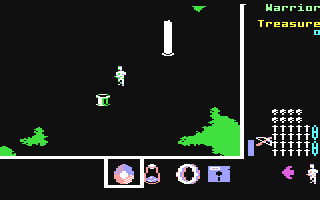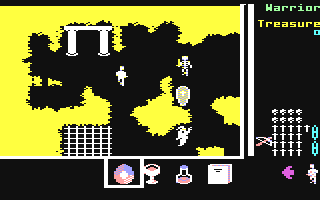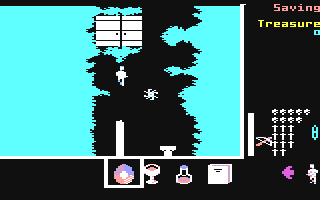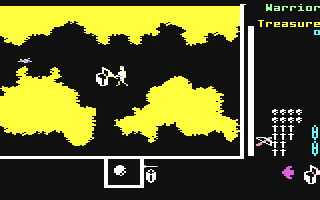|
Despite
its outward similarity to other games in SSI's range
that are definitely what I call 'pseudo-roleplaying'
games, Gemstone Healer is almost an arcade adventure.
It borders on the edge of strategy, but considering
that the manipulative skills required are not very demanding,
the ability to solve puzzles and make decisions between
courses of action determine success. This puts it into
the strategic camp, although it's certainly not a game
that will find favour with those who like characters
with lots of statistics.
Untold
aeons ago, evil demons attacked the peace-loving world
of men, a society that was supported by the mystical
power of the Gemstone. The propensity for fantasy societies
to rely upon single magic items for their economic stability
continues to amaze me, particularly as these gems, shards,
rings and other gadgets are so clearly vulnerable to
being captured and destroyed by antisocial demon hordes.
In what I understand to be the previous game, the Gemstone
was stolen and shattered into five fragments by the
demons. You, in your usual role of suicidally brave
adventurer, have already fought your way through the
underworld to collect the five pieces and reassemble
them into the complete gemstone. But to your considerable
chagrin, the gemstone doesn't work! The guarantee ran
out long ago, and the shop refuses to exchange it .
. . so you go on a long and uncomfortable trek across
a few Unknown Mountains to find the castle of the immensely
knowledgeable Wizard Un-named. He pronounces the Gemstone
to be in a bad way; it has lost the balance of the fundamental
forces, and must be split up again and reassembled according
to the instructions, which are, unfortunately, lost.
You sigh with resignation as you realise that this means
yet another highly dangerous trip to the demon plane
. . .

The
essential points to be distilled out of this predictable
waffle (and I must admit that I'm getting impatient
with the fatuous unoriginality of fantasy scenarios)
are that you have to search through a complex maze of
cavern-like rooms for a pair of 'splitting tools', six
alters and twenty-five healing tools. You already have
the gemstone, so once you find the splitting tools you
can reduce the gemstone into five fragments on one of
the altars, place each fragment on one of each of the
other five, and attempt to find the correct combination
of healing tools to mend them and eventually bring them
all back together.
Before
you start, the game requires you to prepare a 'map disk'.
This is something which infuriates me, but two factors
mitigate the inconvenience in the case of Gemstone
Healer's: the map disk doesn't take half an hour
to format, and you are very thoughtfully permitted to
use the back of the game disk itself. I gritted my teeth
only very slightly. If you haven't played before, the
programmer generates an entirely new map for you, and
ingeniously takes the name you choose for the disk as
the random seed from which to begin. The same first
12 characters will always generate the same dungeon.

The
program amuses itself for several minutes constructing
the dungeon, then -- when you've come back from making
a cup of coffee -- it is ready to begin without further
dice-rolling or ado. This is not a roleplaying game
and does not require you to roll up a character. Your
brave adventurer is ready to go from the start, equipped
with a sword, a crossbow, and a random selection of
magic items. After choosing from one of three levels,
you are presented with some introductory animation (which
you can skip) showing your adventurer running up to
the castle of Wizard Un-named, being told to go on the
quest, and being transported in a spinning vortex to
the alternative dimension where the adventure takes
place.
The
main screen is strongly visual in its presentation of
the game information. The largest panel is taken up
with the area of action, displaying what at first I
assumed to be an island landscape but quickly realised
was on underground room with irregular walls. The adventurer
is a smallish figure suitably equipped with the weapon
selected at the time. Exits from the room, which is
usually several times larger than the screen, are clearly
displayed in the form of doors, archways or gratings.
Apart from the occasional redundant pillar and very
important altar, the rooms are otherwise devoid of feature.

Below
the 'viewscreen' is a row of items carried in the adventurer's
inventory. These are the magic items, splitting and
healing tools, and bits of Gemstone. At the beginning
of each new game the adventurer has a different selection.
They are clearly illustrated in the rulebook, along
with a description of their effects: there are 14 magic
items altogether, including an 'Ancient Black Thing'
which creates illusion and looks suspiciously like a
computer disk! At the side of the screen are panels
displaying other information, like the number of crossbow
bolts you have left in your quiver, the 'treasure count'
-- which serves, rather crudely, as a highscore indicator
-- and the location of secret doors, if you're using
the magic dagger.
When
he first arrives in the land, the adventurer is alone
in the first room. Wait around for any length of time
and company soon arrives.

Since
the main business of the game is to find objects, and
objects can only be found on the dead bodies of various
nasties, it follows that the extermination of the unpleasant
creatures who inhabit the land is the way to get on
in the world. There are six 'normal' monsters, three
demons -- demons are the monsters most likely to carry
out the sort of thing that you're looking for -- and
a nasty thing called a 'summoning eye', which spews
forth endless antagonists. Each type of creature has
its own distinctive noise, so you can hear it coming
and identify it even before it makes its appearance
on the screen.
The
best way to kill these monsters is to stand well back
and shoot crossbow bolts at them. This is where arcade
skills, such as they are, come into the game. The game
becomes slightly reminiscent, at this point, of Gauntlet,
but the monsters do not move very fast, are not very
copious (on the beginner's level, anyway) and cannot
do you any damage unless they come directly into contact
with you. Also, unless there's a 'summoning eye' around,
there are only ever a limited number of monsters in
each room. Once all are eliminated, you can ransack
their bodies at leisure. Most monsters carry some sort
of magic items, or gold; items are added to your inventory,
if you have sufficient space, and gold goes into the
'treasure count'.

It
is not difficult to find the splitting tools necessary
to shatter the Gemstone into five fragments, but healing
tools are thinly spread and entirely obscure as yet
in their application. I came nowhere near solving the
puzzle, but the simple pleasure of roaming through the
seemingly endless number of rooms, shooting monsters
and gathering items and treasure was enough to keep
me entertained. Gemstone Healer shares this characteristic
with an arcade game: it can end with appalling abruptness.
If you have a particular magic item in your possession
at the time of your death, you are eligible for resurrection.
Otherwise, it's back to the castle screen for another
attempt.
The
magic items have a variety of interesting effects. The
'ancient black thing' changes your adventurer into a
skeleton, the ring makes him invisible, and there's
a useful dagger which helps you find secret doors. The
caverns are also mappable, and the designer in the 'tips'
section of the rulebook suggests a diagrammatic way
of doing so.
|